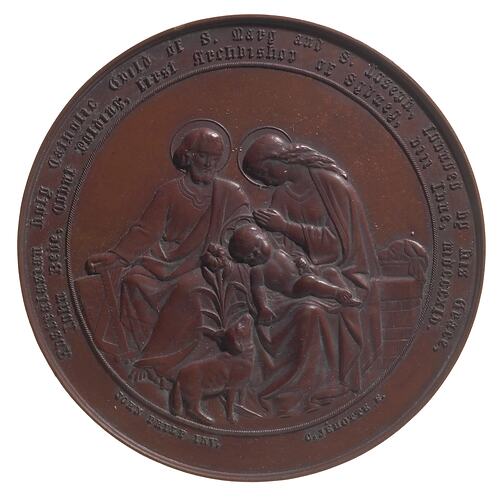Sydney's first bishop, John Bede Polding OSB, was born in Liverpool, England, on 18 October 1794. At the age of nine he was sent to school at the Benedictine Monastery of St. Gregory. Polding studied studiously for five years, then received the Benedictine habit. He made his vows at the age of 12, and was ordained into the Priesthood at 25. Over a 19-year period he held the offices of parish priest, prefect, novice-master and sub-prior at the Monastery. Meanwhile, the Catholic community in New South Wales was beginning to realise that it needed a strong, enthusiastic leader, and the Holy See decided Polding was the man they needed. He was proclaimed the first Bishop of New South Wales on 29 June 1834, and was also given the responsibility of looking after New Holland (the rest of mainland Australia) and Van Diemen's Land (Tasmania).
Polding arrived in Sydney on September 13, 1835. St. Mary's Chapel became his cathedral, and he started work ministering to the 20,000 Australian Catholics. Polding initially adopted a hands-on approach, and often said Mass daily in different locations, heard numerous confessions and attended to the needs of the sick and dying. He also attended the spiritual needs of prisoners, giving Mass and guiding 7000 prisoners in their retreats between 1836 and 1841. Due to the success of these retreats Polding and his priests were allowed to work with all Catholic prisoners when they first landed in the colony.
Polding travelled to Rome in 1841, and fought for the establishment of a recognised hierarchy in the colony. He made a good impression, and in 1842 was made the vicar Apostolic, and became the first Archbishop of Sydney and Primate of Australia. He was also sent on a diplomatic mission to Malta, which Pope Gregory XVI considered very successful and, as a result, he was made a Count of the Holy Roman Empire and assistant at the pontifical throne.
Polding returned to Australia in 1843 to be greeted with anger and suspicion. The hierarchy of the Church of England was not impressed by having an Archbishop in their midst, whilst Irish Catholics were disappointed at the appointment of an Englishman as their Archbishop. However, Polding's gentle actions and dedication allowed him to gain the respect of his opponents.
For the next 30 years Polding worked to create a truly Australian Catholic Church. He was a recognised academic, and fought for the right of people to be educated. He particularly wanted to see locally-born priests, statesmen, lawyers and physicians. He helped establish the University College of St. John, Sydney and Mary's College, Lyndhurst. He also established the monasteries of St. Mary's, Sydney (1843) and Subiaco, Rydalmere (1849).
Wanting to help the poor and disadvantaged, in 1857 Polding founded the first Australian religious community, The Sisters of the Good Samaritan of the Order of St Benedict. The Order was intended to cater to the needs of women, children and First Peoples. Polding also travelled throughout the colony preaching and praying. In one month alone he travelled over 1500 kilometres on horse-back.
Polding returned to Europe in 1851, 1865 and, again, in 1870 to attend the First Vatican Council in 1870. However, ill-health forced him home. The Holy See hastily appointed Dom Roger Bede Vaughan as his assistant, and Polding gradually retired from active work in favour of Vaughan. His final years were spent raising funds to re-build St. Mary's Cathedral, Sydney, which had been destroyed by fire in 1865.
Archbishop John Bede Polding died in office on the 16th of March 1877 at Sacred Heart Presbytery, Darlinghurst, and was succeeded by Vaughan.
References:
Catholic Archdiocese website http://www.sydney.catholic.org.au, accessed 30 Sep 2003.
Catholic Weekly on-line http://www.catholicweekly.com.au/, accessed 30 Sep 2003.
Xavier College web site http://www.xavier.sa.edu.au/houses/polding/, accessed 30 Sep 2003.
More Information
-
Keywords
-
Localities
-
Authors
-
Article types

